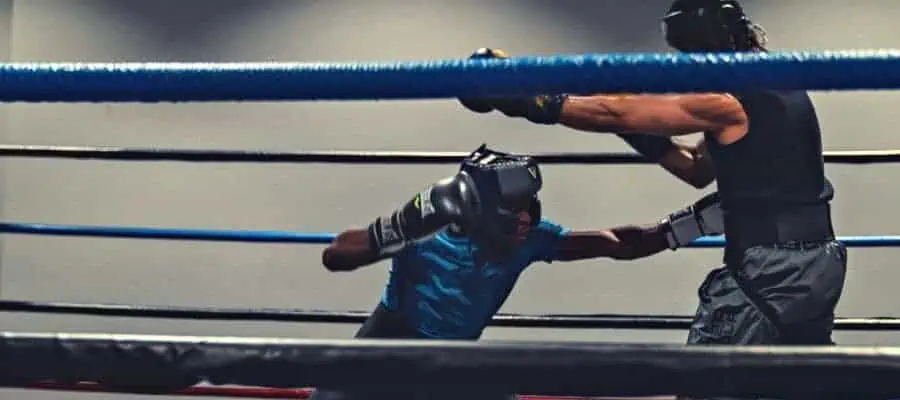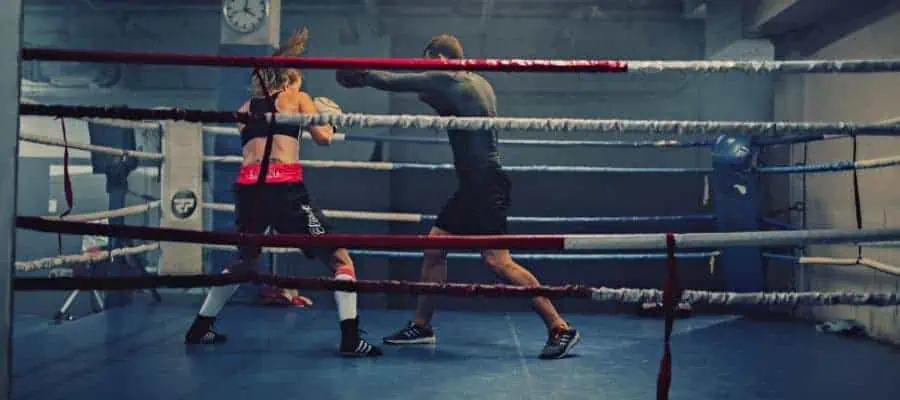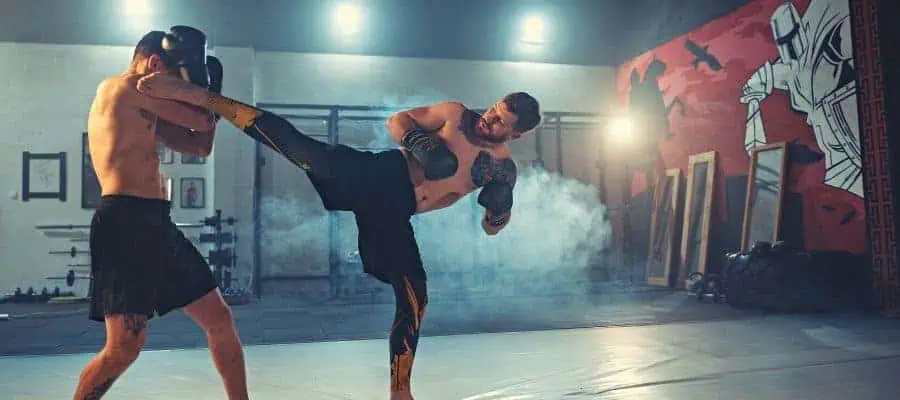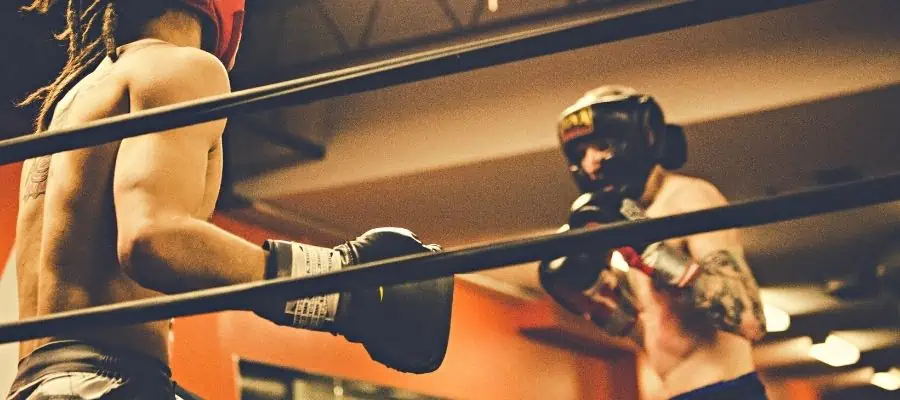When it comes to martial arts, there is a big difference between fighting and sparring. In a real fight, the goal is to hurt and dominate your opponent. This holds for almost all martial arts, such as boxing, kickboxing, and MMA. However, in a sparring match, the goal is to improve your skills while avoiding injury. But what are the things that make a sparring session different than a real match?
All respected martial arts use sparring as a training tool. MMA, Kickboxing, Boxing, and BJJ, all use sparring as a training tool. However, the approach to a sparring session and a real match tend to differ quite a lot.
Sparring Is Used As A Tool, While A Real Fight Is A Competition

Sparring is used as a tool to help martial artists learn and grow. It is not meant to be a competition but rather a way to practice techniques and gain experience. A real fight, on the other hand, is a competition. Some rules and regulations must be followed to ensure fairness and safety.
While training a certain martial art, there are numerous tools you can use to grow your skillset. If you are training a striking-based martial art, then you use many different tools. Tools such as regular technique drills and pad work. You probably also do some work on the heavy bag. If you are training BJJ, for example, or wrestling, you probably put in tons of technique practice each session.
However, all the respected martial arts have one thing in common. And that is they all use sparring as a learning tool. Sparring offers you the chance to try and test out the techniques you have learned before. You can also be sure that you will not get serious injuries during sparring.
While sparring, you can be relaxed and playful, which will give you confidence. You will be able to try out different techniques you wouldn’t otherwise try in a real fight. While sparring, you can always call for a timeout if you are not feeling the best. But, if you did the same during a fight, you would lose the match.
While in a real match, you have to be on top of your game. This means you cannot allow yourself to make mistakes as you could while sparring. But you also mustn’t be too stiff. You should also be sort of playful and relaxed, just as you were during sparring. But you should also keep in mind that your opponent will not pull his punches or kicks. The fight could be over in an instant if you are not careful.
While Sparring, You Carry Extra Protection

If you train in a striking-based martial art, then you carry the standard equipment. The equipment used in a match and during a sparring session is often similar but not the same. Fighters during a boxing match have 10 oz or 12 oz gloves, depending on the organization. They also have a mouthguard and a groin guard. That is all the protective equipment they need and can have in a real fight.
But, during sparring, fighters wear extra protection to avoid hurting themselves during training. During a sparring session, fighters usually have larger, more padded gloves. The most common sparring gloves are the 16 oz gloves. It offers extra protection both for the fighter’s fists and his opponent’s face. During a boxing sparring session, younger boxers often wear padding for their abdomen.
The younger fighters as rule do not have the best-developed abs muscles. So they usually wear protective gear for that region. This padding prevents unnecessary injuries. Boxers also use headgear to protect their head from unnecessary injuries. The sparring helmet helps the boxers reduce the amount of head trauma they receive. The sparring helmet can also prevent cuts to the fighter’s face when he gets hit properly.
Kickboxers and MMA fighters alike use additional protective gear while sparring. They also use headgear to protect against head trauma and cuts. Another important piece of gear is the shin guards. They are used to protect both the fighter who throws the kick and the one who receives it. The shin guard keeps the fighters’ shins protected since it offers extra padding to the shin.
The shin, if not trained well, can easily break, which can be quite painful. A shin brake could endanger the fighter’s whole career. Shins are especially in danger when a fighter throws a strong low kick, and the other fighter checks it. To check it means to block the kick with a shin. This can lead to some serious injuries.
Muay Thai fighters, for example, also use protective gear for their elbows. Since in Muay Thai, elbows are one of the main weapons to hurt your opponents, they are quite dangerous. To avoid deep cuts to their training partner, elbow pads are often used as a way to diminish the damage.
You Change Your Opponents Between The Rounds While Sparing

There are some key differences between a sparring session and a match. First, you change your opponents between the rounds while sparing. This allows you to work on different techniques and strategies against different people. In a match, you fight the same person for all three rounds. This can be an advantage or disadvantage, depending on your opponent’s style.
Sparring with different people will expose you to different fighting styles. It will help you to develop a more well-rounded skill set. You will be sparring both tall and short opponents. Maybe you will be sparring a fast smaller training partner and a big powerful one in the same sparring session. This will help you to learn how to fight against all different types of opponents.
You will learn how to adapt to different fighting styles. For example, you will be sparring with a sparring partner with a longer reach than you. Therefore you will have to be quick and get into the “pocket” fast. If you do not close the distance fast, you will be attacked with jabs and crosses. During the three minutes of sparring, you will most likely adapt to your opponents’ way of fighting.
However, the round will finish, and you will have to find a new sparring partner. Maybe in the next matchup, you will be the larger one. And your sparring partner will be a smaller but faster fighter. Now you will have to adapt once again to your new sparring partner. In the same way, you had to adapt to your previous sparring partner.
For this reason, sparring is invaluable for a serious fighter. Sparring will prepare you to adapt as fast as possible during a fight. If your opponent during a match changes style, you will be ready to react and adapt. Just like Bruce Lee said: “Be as water, my friend.”
There Is No Winner In A Sparring Match

When you spar, your goal is not to win but to learn. You are not trying to score points or take your opponent down. You are simply trying to improve your skills and techniques. Sparring is the best time to try and practice what you have learned that week. It is a “no judgment” zone where you can try and fail over and over again.
A match, on the other hand, is all about winning. The goal is to score points and/or take your opponent down. There is a winner and a loser in a match. There is not much place for trying out new risky techniques. The judges will notice if you try techniques you have not mastered. And this might affect the way they score the fight. Therefore in a fight, stick to the moveset you have learned.
Sparring is a great way to practice your techniques and get better at your martial art. It is also a great way to meet other people and make friends. However, it is important to remember that there is no winner in a sparring match. So don’t go into a sparring match to win. So focus on improving your skills and techniques.
It is important to go easy during sparring. As I said earlier, sparring is supposed to be playful and fun. But it is also supposed to be challenging and a little bit punishing. But keep in mind that you need to be careful with the amount of force you put behind your punches or kicks.
The last thing you want to do is to escalate a sparring session and turn it into a full-blown fight. For example, you throw a hard punch, which makes your sparring partner throw an even harder punch. Soon enough, both of you will be trying to take each other’s heads off. When a sparring session escalates, injuries often follow.
A sparring session should have to be interrupted and stopped just because you and your training partner escalated the situation. Knockouts and injuries do happen, even during sparring sessions. Most of them, however, are due to a well-placed shot, maybe even an accidental one. Knockout during sparring shouldn’t occur because of two training partners exchanging full blows. Remember, both of you are there to learn.
A Sparring Session Is Less Intense Than A Real Match

A sparring session is less intense than an actual match. The pressure isn’t as high, and the goal is simply to gain experience and improve your skills. In a sparring match, you can try out new techniques without the fear of losing.
In an actual match, however, the stakes are much higher. Every move counts, and there is a winner and a loser. The goal is to win at all costs, which means that the intensity level is much higher. You can’t afford to make any mistakes, or your opponent will take advantage of them.
Sparring sessions can get intense sometimes. Especially when the whole team is at the end of the camp. The end of the camp is when fighters usually do intense sparring. This type of intense sparring prepares the fighters mentally for a real match.
But it is also important to be careful during this type of sparring. The last thing you want is to hurt yourself or your training partner before your real match.
Bonus: Tips For Your Next Sparring Session

A sparring session is a great way to get some practice in without having to go all-out in a match. This type of training is less intense than an actual match. But it can still provide a good workout and help you hone your skills. Use these tips for getting the most out of your next sparring session.
Work On Your Technique
Sparring is a great opportunity to work on your technique. Use this time to focus on your form and perfect your punches. If you can master the basics of sparring, you’ll be one step closer to becoming a successful fighter.
Stay Calm And Relaxed
One of the biggest mistakes you can make in sparring is getting too tense. This will only make you tire faster and make it harder to throw accurate punches. Instead, try to stay calm and relaxed throughout the session.
Build Up Your Stamina
Sparring is also a great way to build up your stamina. If you can last for several rounds without getting too tired, you’ll be in good shape for an actual match. Try to push yourself during sparring, but don’t overdo it.
Focus On Defense
It’s important to remember that defense is just as important as offense in martial arts. During sparring, work on keeping your guard up and blocking your opponent’s punches or kicks. The more you can practice your defensive skills, the better you’ll be in an actual match.
Have Fun
At the end of the day, sparring is supposed to be fun. So don’t take it too seriously and just enjoy yourself. As long as you’re putting in some good work and improving your skills, that’s all that matters.
Conclusion
Sparring is a great way to train and prepare for a real match, but there are some key differences. Sparring is usually done with lighter contact. And also, without the same level of intensity as a real match. The rules of sparring are often different than the rules of a real match. So you need to be sure that you understand the difference before stepping into the ring. Finally, remember that sparring is just a training tool. It’s not a substitute for actual competition.
Recent Posts
What is Manachai's Fighting Style? Unveiling Muay Thai Mastery
Manachai, a celebrated figure in the Muay Thai world, has captivated audiences with his exemplary martial prowess. Hailing from the heartlands of Thailand, his name is synonymous with the art of...
What Was Chamuekpet Hapalang's Fighting Style? Unveiling Techniques
Chamuekpet Hapalang was a renowned figure in the world of Muay Thai (record 200-48-2), embodying a fusion of Muay Bouk and Muay Khao styles. Originating from Thailand, the art of Muay Thai is known...
